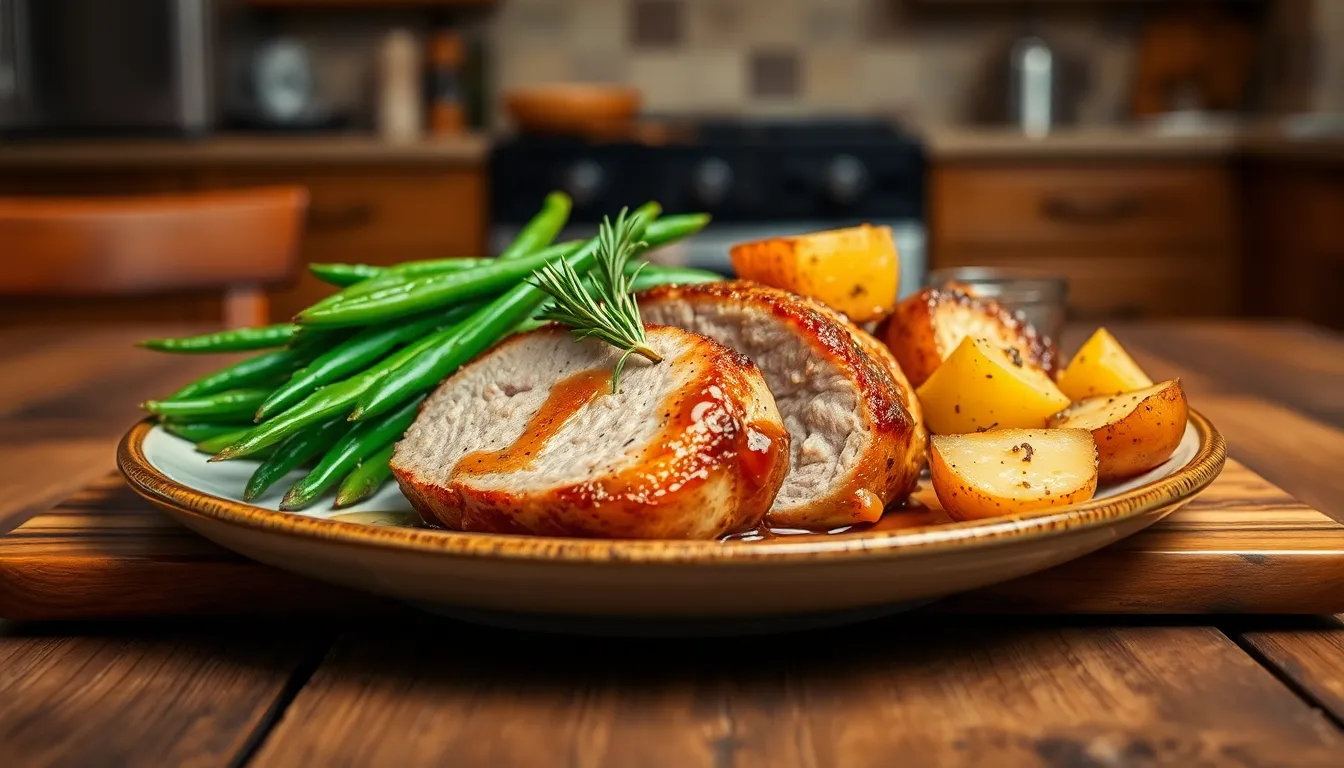
Looking for a foolproof mustard glazed pork tenderloin recipe that’ll impress everyone at your dinner table? This restaurant-quality dish delivers exceptional flavor with minimal effort and basic ingredients you likely already have in your pantry.
Transform an ordinary weeknight dinner into something special with this mustard glazed pork tenderloin. The tangy, slightly sweet glaze creates a beautiful caramelized exterior while keeping the meat incredibly juicy inside. It’s the perfect balance of flavors that pairs wonderfully with almost any side dish, from roasted vegetables to creamy mashed potatoes.
You’ll love how quickly this elegant meal comes together. In just about 30 minutes, you can serve a main course that looks and tastes like you spent hours in the kitchen—but only you’ll know how simple it really was to prepare.
Why You’ll Love This Mustard Glazed Pork Tenderloin
This mustard glazed pork tenderloin will quickly become your go-to dinner option for several compelling reasons:
Restaurant quality at home – You’ll achieve a professional-level dish with minimal culinary skills required. The mustard glaze creates a beautiful caramelized exterior that looks as impressive as it tastes.
Budget friendly – Pork tenderloin offers excellent value compared to many other cuts of meat. This recipe transforms an affordable protein into something truly special without very costly.
Quick cooking time – From start to finish, this recipe takes about 30 minutes to prepare. The tenderloin cooks remarkably fast while still delivering exceptional flavor, making it perfect for busy weeknights.
Incredibly juicy – The mustard glaze works magic by locking in moisture during cooking. Your pork will remain tender and succulent rather than dry and tough.
Versatile pairing options – This recipe works beautifully alongside countless side dishes from roasted vegetables to creamy mashed potatoes or a simple green salad.
Perfect for meal prep – Leftovers maintain their flavor and texture beautifully for several days in the refrigerator. You can easily slice and use in sandwiches or salads throughout the week.
Naturally gluten-free – Without any modifications, this recipe fits perfectly into a gluten-free diet while still delivering maximum flavor.
Ingredients You’ll Need

This mustard glazed pork tenderloin requires simple ingredients that create an impressive flavor profile. Here’s everything you need to gather before getting started.
For The Pork Tenderloin
- 2 pork tenderloins (approximately 1¾ to 2 pounds total)
- 2 tablespoons vegetable oil
- Salt and freshly ground black pepper to taste
- 1 tablespoon unsalted butter
- 1 tablespoon fresh rosemary, finely chopped
For The Mustard Glaze
- ½ cup light brown sugar, packed
- ½ cup grainy Dijon mustard (such as Maille or Grey Poupon)
- ½ cup dry sherry
- 1 tablespoon fresh rosemary, chopped
- ½ teaspoon salt
- ¼ teaspoon freshly ground black pepper
Kitchen Tools Required

Preparing mustard glazed pork tenderloin requires several essential kitchen tools to ensure perfect results. Gather these items before starting your cooking process:
- Oven-safe skillet – Preferably cast iron for searing and transferring directly to the oven
- Mixing bowl – Medium-sized for combining glaze ingredients
- Measuring cups and spoons – For precise ingredient measurements
- Tongs – To safely handle and turn the pork during searing
- Meat thermometer – Essential for checking the internal temperature reaches 145°F
- Sharp knife and cutting board – For trimming silver skin and slicing the cooked tenderloin
- Whisk – For thoroughly blending the mustard glaze ingredients
- Small saucepan – If reducing the glaze separately
- Aluminum foil – For tenting the meat during resting period
- Pastry brush – For applying the glaze evenly to the pork
The right tools make a important difference in preparing this dish efficiently. A reliable meat thermometer is particularly important as it prevents overcooking the tenderloin which can quickly become dry. The oven-safe skillet eliminates the need to transfer the meat between pans allowing you to move seamlessly from stovetop searing to oven roasting while maintaining all the delicious flavors.
How To Prepare The Pork Tenderloin
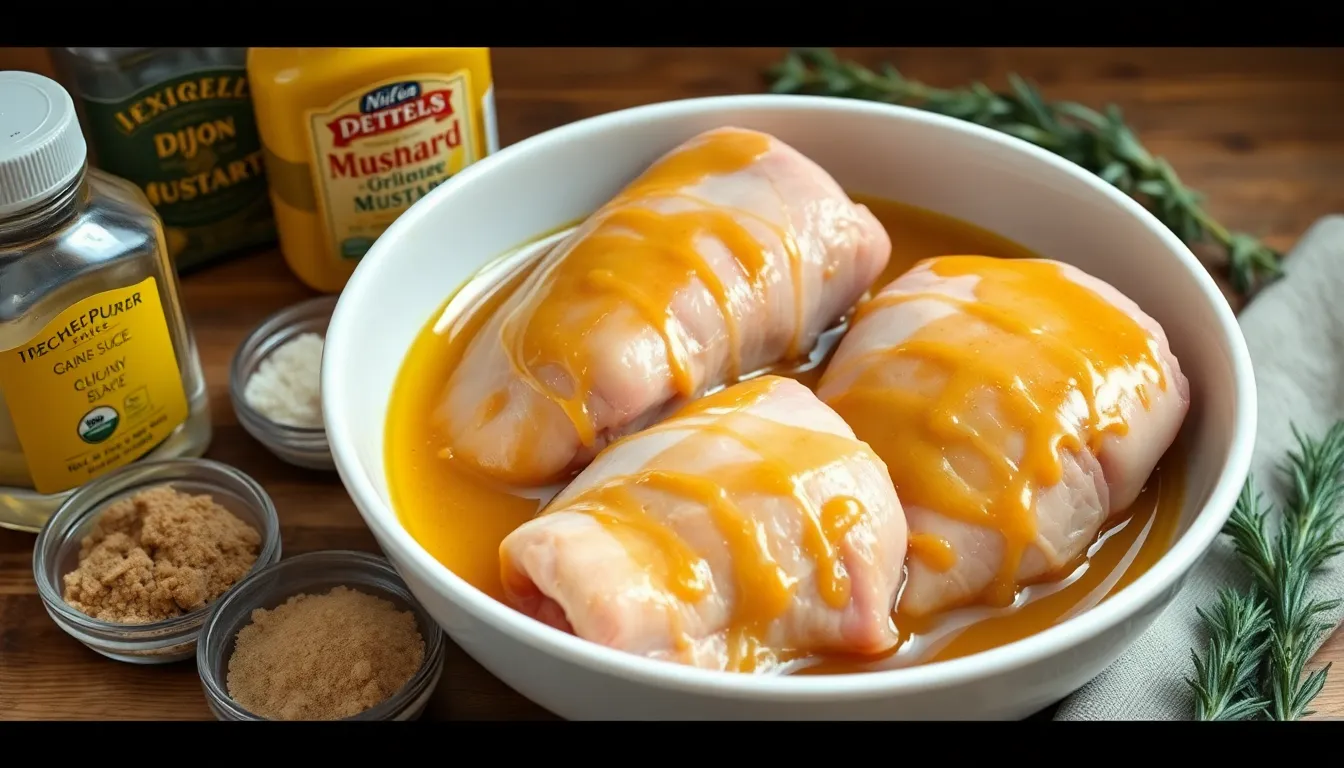
Proper preparation is the key to a juicy and flavorful mustard glazed pork tenderloin. These simple yet crucial steps will ensure your dish turns out perfectly every time.
Trimming And Prepping
Start with 2 pork tenderloins weighing about 1 to 1.5 pounds each. Examine each tenderloin and remove the silver skin – that tough, silvery membrane running along one side of the meat – by sliding a sharp knife underneath it and carefully cutting it away. Trim any excess fat to ensure even cooking and achieve a more tender final texture. Pat the tenderloins completely dry with paper towels, which helps the glaze adhere better to the meat’s surface. Season lightly with salt and freshly ground black pepper on all sides before you apply the marinade. This initial seasoning creates a foundation of flavor that complements the mustard glaze perfectly.
Creating The Perfect Mustard Glaze
The signature mustard glaze combines sweet and tangy elements that transform ordinary pork tenderloin into an extraordinary dish. Gather these ingredients to create your glaze:
- ½ cup grainy Dijon mustard
- ½ cup light brown sugar
- ½ cup dry sherry
- 1 tablespoon fresh chopped rosemary
- Salt and freshly ground black pepper to taste
- 5 tablespoons unsalted butter (for finishing the sauce)
- Vegetable oil for searing
Combine the brown sugar, grainy Dijon mustard, dry sherry, and chopped rosemary in a bowl to create your base glaze. Whisk thoroughly until the sugar dissolves and the mixture becomes uniform. Reserve about one-third of this mixture for the finishing sauce later. Coat the trimmed pork tenderloins generously with the remaining glaze, ensuring every surface is covered. Allow the meat to marinate for approximately 1 hour in the refrigerator to infuse the flavors throughout the pork.
When ready to cook, heat vegetable oil in an oven-safe skillet over medium-high heat. Sear the marinated tenderloins on all sides until they develop a golden brown crust, which typically takes 2-3 minutes per side. Transfer the skillet to a preheated 400°F oven and roast for 20-25 minutes until the internal temperature reaches 145°F. This precise temperature ensures perfectly cooked, juicy meat.
After roasting, remove the pork and let it rest under foil. Use the reserved marinade to create a luscious sauce by deglazing the pan with it and gradually incorporating the butter while stirring continuously. This creates a rich, velvety sauce that beautifully complements the roasted pork when drizzled over the sliced tenderloin just before serving.
Cooking Instructions
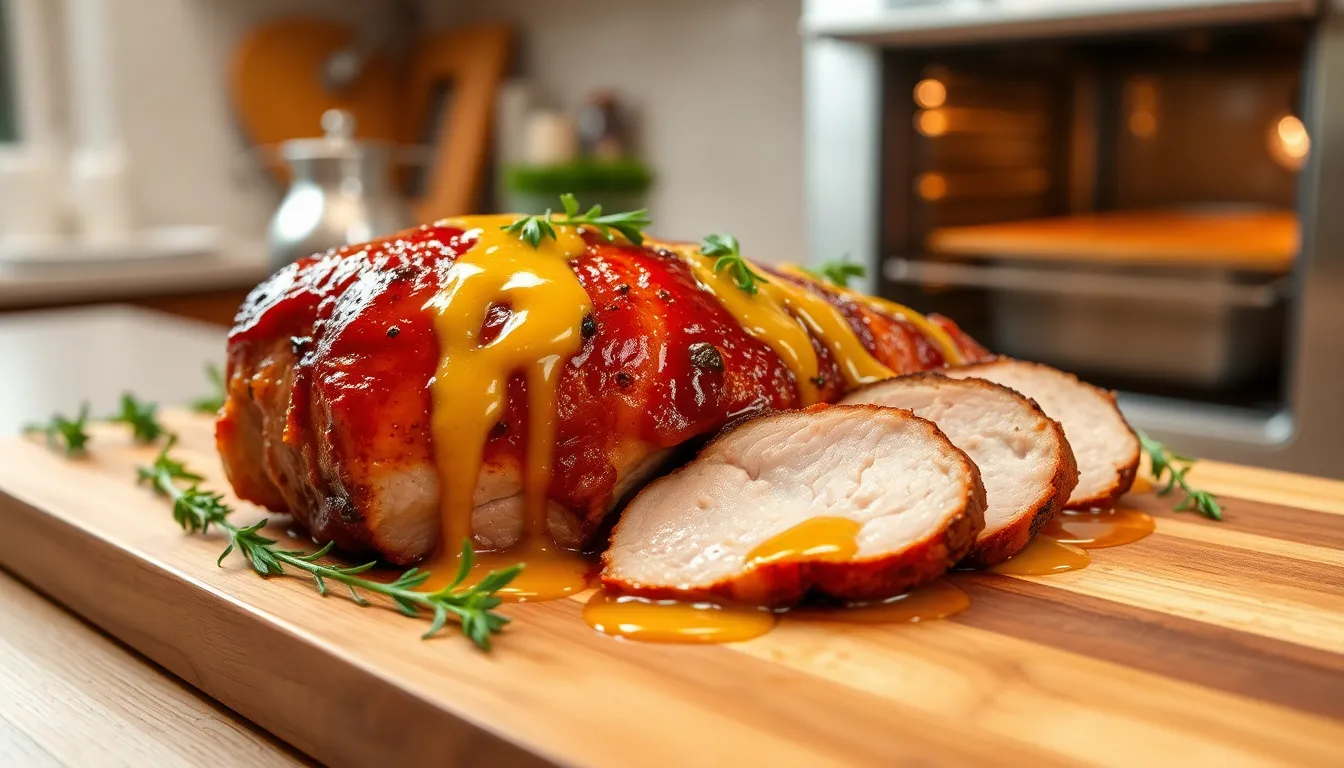
Follow these straightforward steps to create a perfectly glazed pork tenderloin with a caramelized exterior and juicy interior. The combination of searing and roasting ensures restaurant-quality results every time.
Searing The Tenderloin
Heat 2 tablespoons of vegetable oil in your oven-safe skillet over medium-high heat until shimmering. Place the seasoned and marinated tenderloins in the hot pan, being careful not to overcrowd. Cook each side for approximately 2-3 minutes until a rich brown crust develops all around. Turn the tenderloins using tongs to ensure even browning on all surfaces. This crucial step locks in the meat’s natural juices and creates a flavorful foundation for the glaze to adhere to. Leave some space between the tenderloins when searing to ensure proper browning rather than steaming.
Applying The Glaze
Brush additional mustard glaze over the seared tenderloins, making sure to coat all sides evenly. Use about one-third of your prepared glaze at this stage, saving the remainder for the sauce. The heat from the seared meat will help the glaze adhere better and begin caramelizing immediately. Apply the glaze generously but avoid letting too much drip into the pan where it might burn. The combination of brown sugar and mustard will create a beautiful crust during roasting that seals in moisture and adds tremendous flavor.
Roasting To Perfection
Transfer the skillet directly to a preheated 350°F oven with the glazed tenderloins. Roast until an instant-read thermometer inserted into the thickest part registers 140°F, typically 12-15 minutes depending on the thickness of your tenderloins. While the pork roasts, pour the remaining marinade into a small saucepan and bring to a boil for 1-2 minutes. Remove from heat and whisk in 1 tablespoon of unsalted butter until melted to create a velvety sauce. Take the tenderloins out of the oven once they reach temperature and tent loosely with foil, allowing them to rest for 10 minutes before slicing. During this rest period, the temperature will rise to the USDA-recommended 145°F while the juices redistribute throughout the meat. Slice the tenderloin into medallions and drizzle with the prepared sauce before serving.
How To Know When Your Pork Is Done
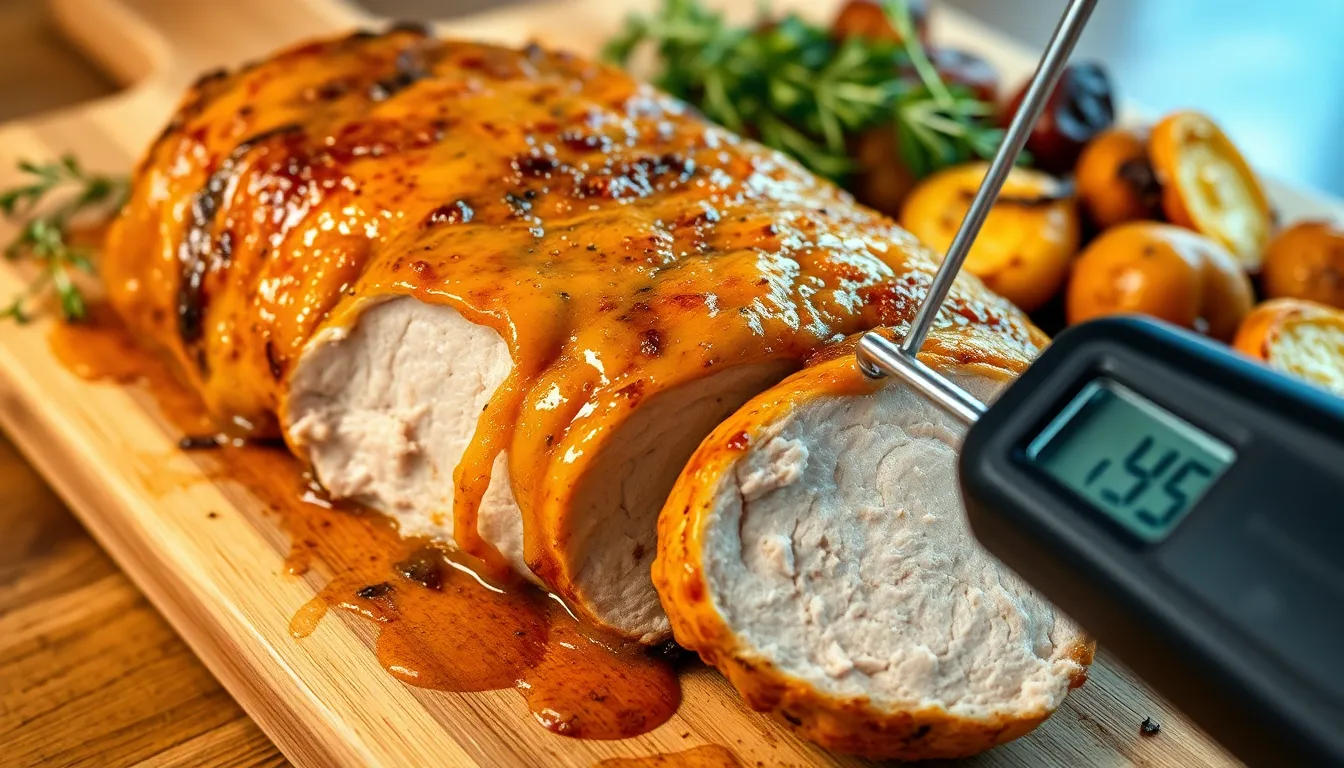
Cooking pork tenderloin to perfection requires precision since this lean cut can quickly go from juicy to dry. The most reliable method for determining doneness is using a meat thermometer inserted into the thickest part of the tenderloin.
The USDA recommends cooking pork to an internal temperature of 145°F (63°C) followed by a 3-5 minute rest period. During this rest time the temperature will continue to rise slightly and the juices will redistribute throughout the meat ensuring optimal tenderness.
At 145°F your pork tenderloin will have a slight blush of pink in the center which is completely safe to eat. This slight pinkness indicates perfectly cooked juicy pork rather than the overdone gray meat many home cooks mistakenly aim for.
Visual and tactile cues can supplement your thermometer reading:
- Properly cooked tenderloin should feel firm but still yield slightly to pressure
- The meat should have an even golden brown exterior from the mustard glaze
- Juices should run mostly clear with just a slight tinge of pink
- The ends of the tenderloin may cook faster than the center
Avoid the common mistake of cooking pork tenderloin past the recommended temperature. The naturally lean nature of this cut means overcooking beyond 145°F will result in dry tasteless meat regardless of how flavorful your mustard glaze might be.
For the mustard glazed pork tenderloin specifically you’ll want to start checking the temperature after about 15-18 minutes of roasting in a 400°F oven. The exact cooking time will vary based on the thickness of your tenderloin and how long you seared it beforehand.
Remember that carryover cooking continues even after you’ve removed the pork from the oven. Pull the tenderloin when your thermometer reads 140-142°F and the temperature will rise to the perfect 145°F during the resting period while you finish preparing your sauce.
Resting And Slicing

After your mustard glazed pork tenderloin reaches the perfect internal temperature of 145°F (63°C), proper resting and slicing techniques are crucial to preserve its juicy texture and maximize flavor.
The Importance of Resting
Transfer your cooked pork tenderloin from the hot skillet to a clean cutting board. Tent it loosely with aluminum foil to maintain warmth while allowing excess steam to escape. Let the meat rest for 5-10 minutes before slicing – this isn’t just a suggestion but a critical step in the cooking process.
During this resting period, the juices redistribute throughout the meat fibers. Without adequate rest, these flavorful juices would escape when you slice into the tenderloin, resulting in dry meat on your plate and lost flavor. The resting process ensures every bite remains succulent and tender.
How to Slice Pork Tenderloin
Once rested, remove the foil and prepare to slice your pork tenderloin:
- Use a sharp knife to cut across the grain of the meat
- Create medallions approximately ¼ to ½ inch thick
- Maintain even thickness for consistent texture and appearance
- Slice with gentle pressure to avoid squeezing out juices
Cutting against the grain shortens the muscle fibers, making each bite more tender. The recommended thickness allows you to appreciate both the caramelized exterior and the juicy interior of each slice.
Serving Suggestions
Arrange your sliced pork tenderloin on a warm serving platter in an overlapping pattern to showcase the beautiful mustard glaze. Drizzle some of your reserved sauce over the slices for an extra layer of flavor and visual appeal. The slightly pink center surrounded by the golden-brown exterior creates an impressive presentation that will delight your dinner guests.
For an elevated dining experience, garnish with fresh rosemary sprigs and serve immediately while still warm. The contrast between the tender, juicy meat and the tangy, sweet glaze reaches its peak when served promptly after slicing.
Serving Suggestions

This mustard glazed pork tenderloin pairs wonderfully with many side dishes that complement its sweet-tangy profile. Consider these perfect accompaniments to create a complete and balanced meal:
Classic Pairings
Mashed sweet potatoes offer a velvety contrast to the caramelized exterior of the pork while echoing the subtle sweetness in the glaze. French green beans (haricots verts) provide a crisp texture and bright flavor that cuts through the richness of the dish.
Roasted potatoes make an excellent starchy side—try them tossed with rosemary to mirror the herbs in your glaze. A fresh green salad dressed with a light vinaigrette balances the meal with refreshing crispness.
Seasonal Sides
During fall and winter months, roasted root vegetables like carrots parsnips and Brussels sprouts enhance the comforting nature of this dish. Spring meals benefit from asparagus or pea shoots that bring brightness to the plate.
Summer gatherings call for grilled corn on the cob or a simple tomato cucumber salad that won’t compete with your perfectly glazed tenderloin.
Sauce Service Options
Serve the reduced mustard sauce drizzled directly over sliced medallions for maximum flavor impact. Alternatively present the sauce in a small pitcher alongside the platter allowing guests to add their preferred amount.
The sauce also tastes wonderful spooned over any accompanying starches like quinoa or rice which absorb the flavors beautifully.
Complete Menu Suggestions
For weeknight dinners pair with:
- Butter lettuce salad with simple vinaigrette
- Roasted baby potatoes
- Steamed broccoli
For special occasions elevate your presentation with:
- Wild rice pilaf studded with dried cranberries
- Glazed rainbow carrots
- Sautéed spinach with garlic
- Warm dinner rolls for soaking up extra sauce
This versatile main dish transitions seamlessly from casual family meals to elegant dinner parties making it a reliable recipe for any occasion.
Storage And Reheating Tips
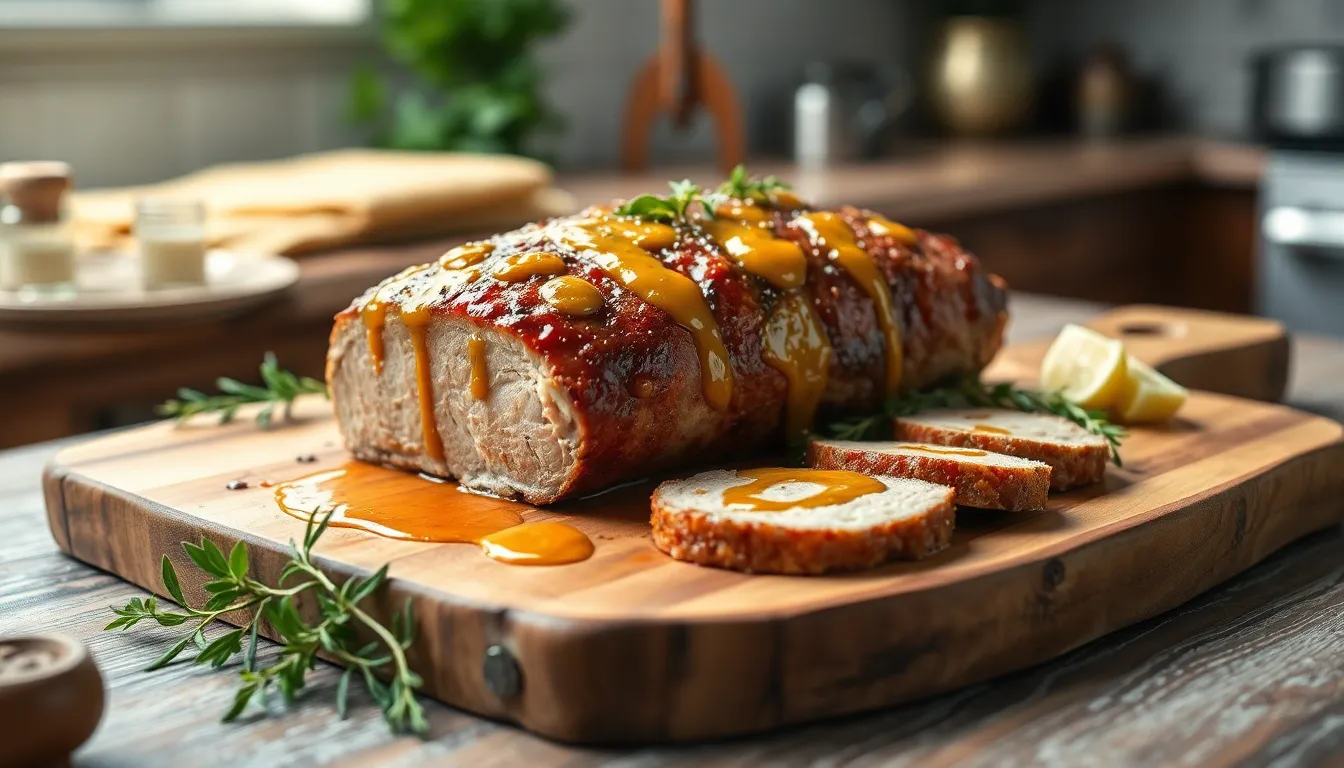
Properly storing and reheating your mustard glazed pork tenderloin ensures you can enjoy leftovers that taste almost as delicious as when freshly made. Follow these guidelines to maintain the flavor and texture of your pork tenderloin.
Refrigerating Leftovers
Store your leftover pork tenderloin in an airtight container to preserve freshness and prevent bacterial contamination. Refrigerated pork tenderloin remains safe to eat for 3 to 4 days while maintaining excellent flavor. Before refrigerating, allow the meat to cool completely but don’t leave it at room temperature for more than 2 hours.
Freezing for Later
For longer preservation, freeze your mustard glazed pork tenderloin by following these steps:
- Wrap the pork tightly in aluminum foil or plastic wrap
- Place wrapped pork in a freezer-safe container or heavy-duty freezer bag
- Label with the date of freezing for tracking
- Consume within 3 to 4 months for best quality
Frozen pork tenderloin can technically remain safe indefinitely when stored at 0°F, but quality begins to decline after 3-6 months.
Thawing Safely
Thaw frozen pork tenderloin overnight in the refrigerator for the safest method that preserves texture. Quick thawing can be done using the defrost setting on your microwave when you’re short on time, but this may slightly affect the meat’s juiciness.
Reheating Methods
Oven Method (Best for Preserving Moisture)
- Preheat your oven to 325°F
- Place pork tenderloin in an oven-safe dish
- Add a tablespoon of water or broth to the bottom of the dish
- Cover tightly with aluminum foil
- Heat for 10-15 minutes until the internal temperature reaches 165°F
Microwave Method (Quickest Option)
- Place pork slices on a microwave-safe plate
- Cover with a damp paper towel to retain moisture
- Heat in 25-second intervals at medium power
- Check temperature between intervals to avoid overcooking
Stovetop Method
- Slice the pork tenderloin into medallions if not already done
- Heat a skillet over medium-low heat with a small amount of oil or butter
- Add the pork slices and warm for 1-2 minutes per side
- Avoid high heat which can dry out the meat
Additional Tips
Remember that accompanying Dijon cream sauces shouldn’t be frozen as their texture may degrade. Instead, refrigerate cream-based sauces separately and use within one week.
The mustard glaze may caramelize further during reheating. To refresh the glaze, brush a small amount of additional glaze on the pork before reheating in the oven for a revitalized flavor profile.
Recipe Variations
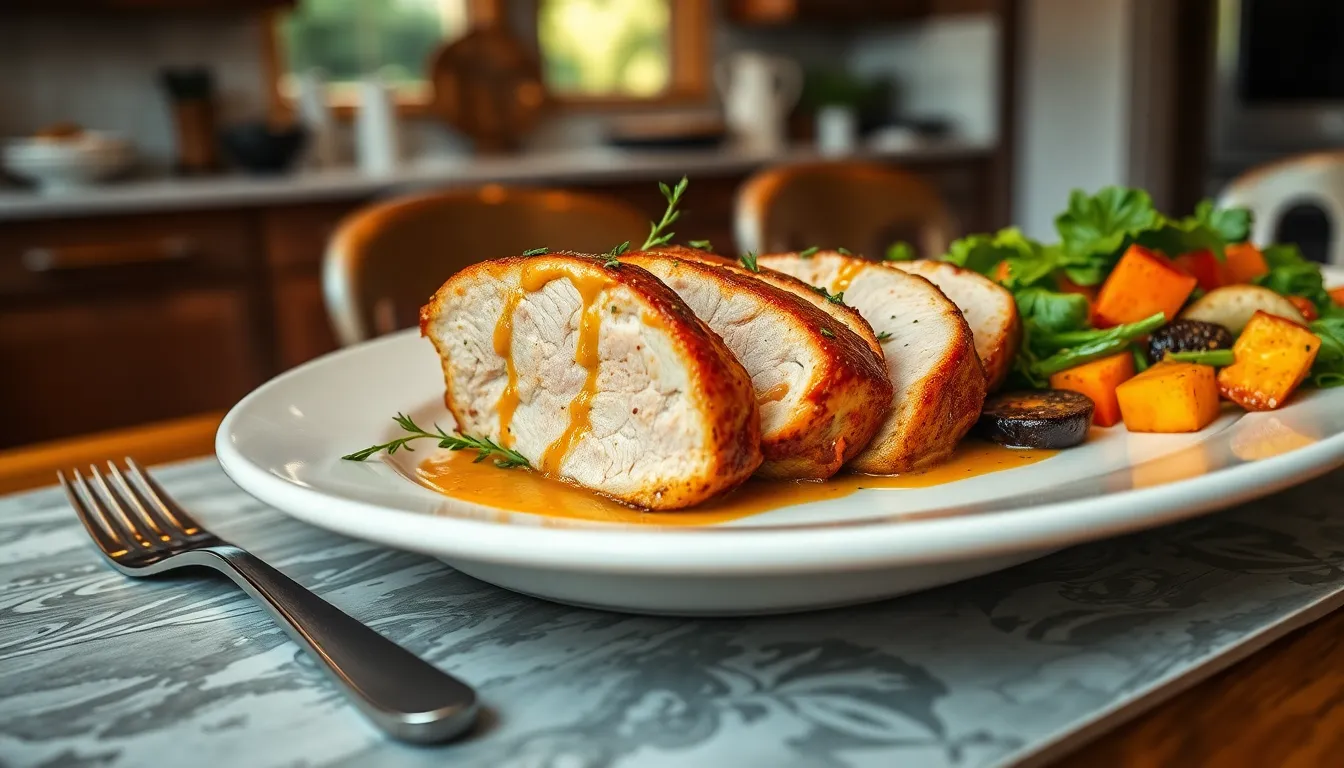
While the classic mustard glazed pork tenderloin is delicious on its own you can easily adapt this versatile recipe to suit different flavor preferences. These variations maintain the dish’s quick preparation time while offering exciting new taste profiles.
Honey Mustard Variation
This sweeter take on the traditional recipe creates a beautifully caramelized exterior that’s irresistible. Swap out the brown sugar for honey to transform the flavor profile completely. Combine ¼ cup honey ½ cup Dijon mustard 2 tablespoons olive oil 1 teaspoon garlic powder ½ teaspoon salt and ¼ teaspoon pepper in a bowl. Rub this mixture generously over your pork tenderloin before roasting at 400°F until the internal temperature reaches 145°F typically 20-25 minutes.
For maximum flavor marinate your pork in the honey mustard mixture for 2-4 hours before cooking. The longer marination allows the honey to tenderize the meat while infusing it with sweet tangy notes. This variation pairs wonderfully with roasted vegetables or a crisp green salad offering a perfect balance between sweetness and savory flavors.
Spicy Mustard Option
Heat-lovers will appreciate this kicked-up version that adds a pleasant warmth to the traditional glaze. Start with the classic mustard glaze recipe but incorporate spicy elements for a delicious punch. Use spicy brown mustard or whole grain mustard as your base then add ¼ teaspoon cayenne pepper or ½ teaspoon red pepper flakes to bring the heat.
The sweetness from brown sugar or honey balances the spiciness creating a complex flavor profile that’s both warming and satisfying. Apply the glaze as in the original recipe then sear and roast according to the standard instructions. This spicy version makes an excellent centerpiece for a dinner with robust side dishes like garlic mashed potatoes or braised greens.
You can adjust the heat level by increasing or decreasing the amount of cayenne or pepper flakes to suit your preference. The spicy mustard option transforms this weeknight staple into something special that will impress even your most adventurous dinner guests.
The Perfect Wine Pairings
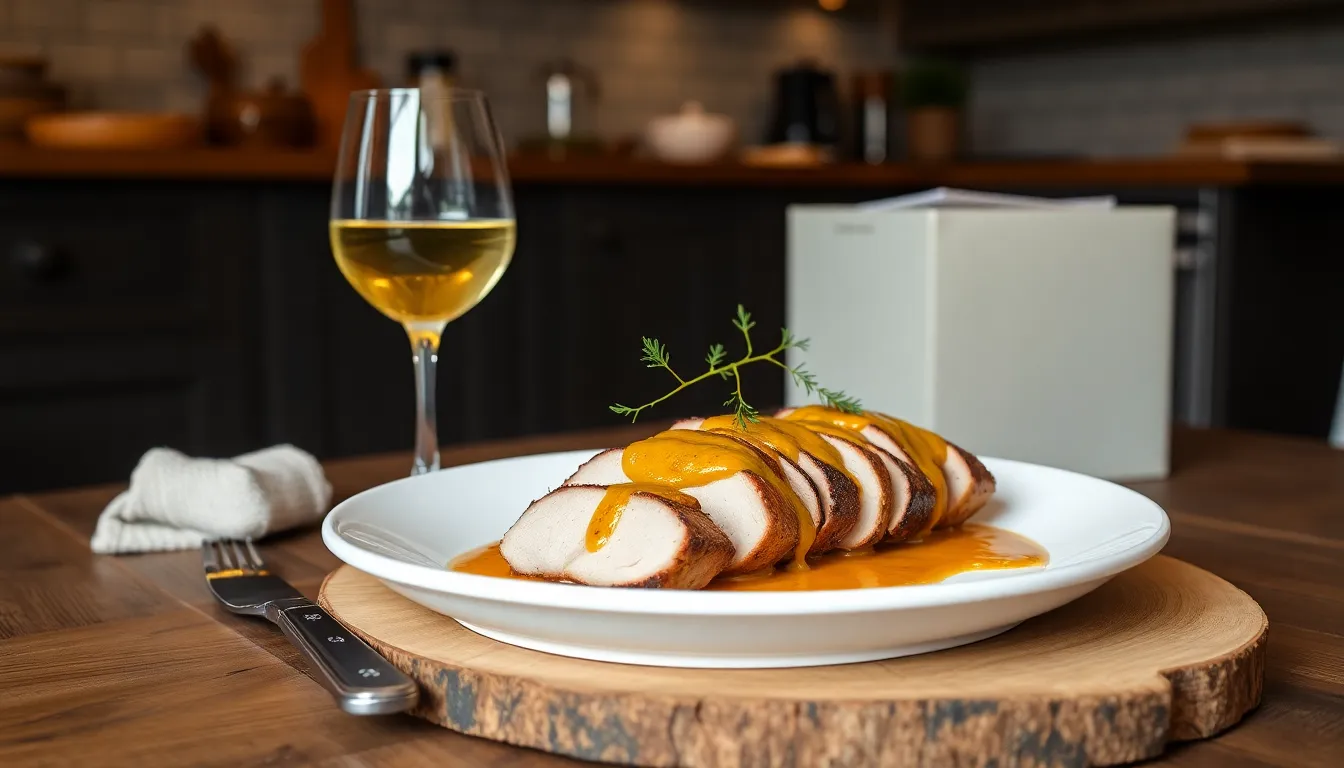
Elevating your mustard glazed pork tenderloin experience requires the right wine companion. The tangy mustard glaze creates unique pairing opportunities that enhance both the wine and your meal. Here are the best wine selections to complement this flavorful dish:
White Wine Options
Gewürztraminer stands out as an exceptional choice for mustard glazed pork tenderloin. Its aromatic profile features spicy and floral notes that perfectly balance the pungent quality of the mustard glaze. The wine’s complexity particularly shines when your recipe includes herbs like rosemary.
Riesling (dry or medium-dry) offers crisp acidity and subtle sweetness that harmonizes beautifully with the tangy mustard elements. This versatile white cuts through the richness of the pork while complementing its tender texture. Pour a glass when serving your tenderloin with creamy side dishes for a balanced dining experience.
Oaked Chardonnay brings buttery and toasty flavors that work wonderfully with the tangy and pungent profile of mustard sauces. The wine’s fuller body stands up to the bold flavors of the glaze without overwhelming the delicate pork tenderloin.
Dry White Muscadine provides refreshing citrus and honeysuckle aromas paired with crisp acidity. This lesser-known option excellently balances the sharp notes in your mustard glaze while improving the natural flavors of the pork.
Red Wine Options
While whites generally pair best with this dish, Pinot Noir offers a red wine alternative that works surprisingly well. Its light-bodied character, bright acidity, and subtle fruitiness complement the mustard-glazed pork without overpowering it. This pairing works especially well when your recipe includes additional herbs like herbs de Provence in the marinade.
| Wine Type | Flavor Notes | Best Pairs With |
|---|---|---|
| Gewürztraminer | Spicy, floral, aromatic | Rosemary-infused mustard glazes |
| Riesling (Dry/Medium-dry) | Crisp, slightly sweet, acidic | Tangy mustard glazes, creamy sides |
| Oaked Chardonnay | Buttery, toasty, rich | Sour or creamy mustard components |
| Dry White Muscadine | Citrus, honeysuckle, crisp | Sharp mustard flavors |
| Pinot Noir | Light fruity, acidic | Herb-enhanced mustard glazes |
Serving your wine at the proper temperature enhances the pairing experience. White wines should be chilled to 45-50°F while Pinot Noir tastes best slightly cooled at 55-60°F. Pour your selected wine about 15 minutes before serving the pork tenderloin to allow its flavors to fully develop and create the perfect complement to your meal.
Conclusion
This mustard glazed pork tenderloin transforms an ordinary dinner into something truly special. With its perfect balance of tangy sweetness and savory depth you’ll love how the caramelized exterior gives way to juicy tender meat.
Try this recipe once and you’ll understand why it deserves a permanent spot in your meal rotation. The combination of simple ingredients accessible techniques and impressive results makes it ideal for both weeknight dinners and special occasions.
Whether paired with seasonal sides or enjoyed as leftovers the next day this dish delivers restaurant-quality flavors without the fuss. Your family will request it again and again proving that sometimes the most memorable meals are also the most straightforward.
Frequently Asked Questions
What makes this mustard glazed pork tenderloin special?
This dish stands out because it creates restaurant-quality flavor with minimal effort using common pantry ingredients. The tangy, sweet glaze caramelizes beautifully while keeping the meat incredibly juicy. It’s budget-friendly, quick to prepare (about 30 minutes), naturally gluten-free, and perfect for meal prep as leftovers maintain their quality for days.
How do I know when the pork tenderloin is perfectly cooked?
Use a meat thermometer to ensure the internal temperature reaches 145°F (63°C), then rest for 3-5 minutes. Properly cooked tenderloin will have a slight blush of pink in the center (indicating juiciness) and feel firm yet slightly yielding. The exterior should be evenly golden brown. For best results, remove from the oven at 140-142°F to account for carryover cooking.
What sides pair best with mustard glazed pork tenderloin?
The sweet-tangy profile pairs beautifully with mashed sweet potatoes, French green beans, roasted potatoes, and fresh green salads. For seasonal options, try roasted root vegetables in colder months or grilled corn and tomato cucumber salad in summer. The reduced mustard sauce can be drizzled over both the pork and sides.
Can I make this recipe ahead of time?
Yes! Store leftover pork in an airtight container in the refrigerator for 3-4 days or freeze for up to 3 months. When reheating, use low heat methods (oven at 325°F with a splash of liquid, covered with foil) to maintain moisture. Consider saving extra sauce separately to refresh the flavor when serving leftovers.
How can I modify the mustard glaze for different tastes?
Try a honey variation by substituting brown sugar with honey for a sweeter, more caramelized finish. For spice lovers, add cayenne pepper or red pepper flakes to the standard glaze. Both variations maintain the quick preparation time while offering different flavor profiles to suit your preference.
What wine pairs best with mustard glazed pork tenderloin?
White wines like Gewürztraminer, Riesling, or Oaked Chardonnay complement the sweet-tangy glaze beautifully. If you prefer red, choose a light-bodied Pinot Noir that won’t overpower the pork. Serve whites chilled (45-55°F) and reds slightly cool (55-65°F) to enhance the dining experience.
What kitchen tools are essential for this recipe?
You’ll need an oven-safe skillet (preferably cast iron), a medium mixing bowl, measuring cups and spoons, tongs, a meat thermometer, a sharp knife and cutting board, a whisk, a small saucepan, aluminum foil, and a pastry brush. The meat thermometer is particularly crucial to prevent overcooking.
How should I slice the pork tenderloin for serving?
After resting for 5-10 minutes to redistribute juices, slice against the grain into medallions ¼ to ½ inch thick for optimal tenderness. Arrange on a warm platter, drizzle with reserved sauce, and garnish with fresh rosemary for an impressive presentation that highlights both the caramelized exterior and juicy interior.



